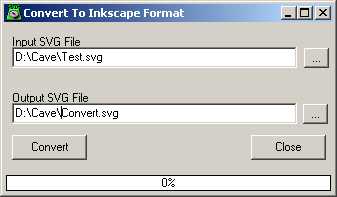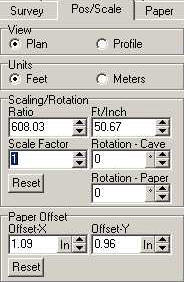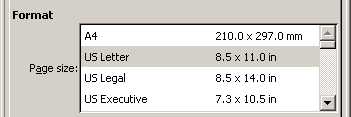|
Conversion and
Adoption |
This section describes how
to work with maps that were generated in other drawing programs,
generated by other cave survey programs or were never processed by a
cave survey program.
| 1. Converting Adobe
Illustrator Maps To Inkscape. The
layering system in Inkscape is slightly different from that in
Adobe Illustrator. If you load an Illustrator map into Inkscape,
the drawings will be shown, but the layers won't show up in the
Layer Display. To solve this problem, the SVG Exporter has a
special conversion tool that will add the necessary information
to the SVG file to allow it to be used in Inkscape. |
| To access the
conversion tool, select the "Tools -> Convert to Inkscape
Format" option from the menu bar. The dialog shown to the right
will be displayed. Begin by filling in
the "Input SVG File." This will be the file you want to convert.
If you press the button just the right, it will take you to the
standard file-opening window and you can select the file that
way. |

|
| Next fill in the
"Output SVG File." You should choose a file with a different
name so that if something goes wrong, you won't lose your
original data. When you have filled in
the file names, press the "Convert" button. The file will be
converted and you now should be able to read the file in
Inkscape and all the layers will show up.
|
| 2. Files Generated By
Other Survey Programs. The SVG
Exporter can operate on SVG files generated by other programs.
At this point, the only other survey program that generates SVG
files is Walls. Walls and Compass use the same layering system,
but Compass adds some layers for your convenience. If you plan
to use a Walls-generated file with Compass, you can have the SVG
Exporter add the the Compass-specific layers to your file. This
shouldn't have any effect on the files usability in Walls, there
will just be some extra layers that Walls should ignore.
|
| To do this, you
perform the normal
Merge/Morph process, but you enabled the "Replace Missing
Layers" option as illustrated in the image to the right. During
the Merge/Morph process, the program will examine all the layers
in the file and replace any that are missing. |

|
| Be sure to save the
merge file to a different filename so that in case something
goes wrong, you won't lose your data. |
| 3. Adopting Files.
If you have an SVG map that was not generated by
Compass or Walls and doesn't have the required layers to
work with a cave survey program, you can use the SVG Exporter to
make it useable in either program. I call the process "Adopting"
a map. The process is a little tedious,
but once is completed, the work of maintaining the map will be
simplified. You'll be able to perform the same Merger, Adjust
and Morph operations as any map that was originally created with
Compass.
Here is a complete description of the needed
for adopting a map.
A. Load The Plot File.
To Adopt a map, you need a Compass Plot File for
the cave in your drawing. The file doesn't have to exactly match
the cave drawing. It can be newer and have additional passages.
When you have located the file, load it into
the SVG Exporter using by selecting the "File -> Open" option
from the menu bar. |
| B.
Match the Scale, Position and Rotation.
You should now adjust the scale, position and rotation of the
cave to match the SVG map. You can do
this using the Pos/Scale page on the left side of the program.
If you know the scale of the map, enter it here. If you don't
know the scale, manually adjust the cave until it appears to be
the right scale. Click here for
Manual Adjustment
Tricks.
Likewise, adjust the Paper Offset to match the
image in your drawing program. Again, this will be a manual
adjustment. Click here for
Manual Adjustment
Tricks. |
 |
| C. Set The Paper Size.
Using the "Paper" page, set the paper size. You should be able
to tell the paper size by checking the settings in your drawing
program. In Inkscape you can view the paper size by selecting
the "File -> Document Properties" option from the menu bar. |

|
| D. Perform A Merge.
Now, you perform the normal Merge/Morph
process, but you enabled the "Replace Missing Layers" option as
illustrated in the image to the right. During the Merge/Morph
process, the program will insert all the necessary layers into
the file, making it compatible with the Compass and Walls.
Be sure to leave the Exporter running when you
finish the export in case you need to make changes. |
 |
| E. Check The Shot Positions.
You should now open the newly created merge file in your drawing
program and check that shots are in the right position relative
to the passage outlines. Since we haven't integrated your
drawings with the newly installed layers, you may have to turn
layers on and off to be able to compare the positions of the
passages and the walls. |
| The shot-lines and station markers appear
under the "w2d_Survey" layer in the w2d_Markers an w2d_Vectors
layers. Be sure all three enabled. You
also may have to disable any obscuring layers, such as the
w2d_Background layer. |

|
| If the passage shot-lines don't
match passage outline position, try adjusting the positions in
the Exporter and re-merging the data. Keep doing this until the
passage shot-lines are in the right position. |
| D. Put Drawings In The Proper Layers.
The final step is to put the all your
drawings, symbols, text and information into the proper layer.
Since each layer has a different role, you want to put certain
drawing elements into certain layers. For example, you want to put all
your passage outline drawings in the w2d_Walls_shp layer so the
Exporter will warp the passage properly if the cave data
changes. To move the your data into the
layer you will be using cut and paste operations. The detail
vary between drawing programs. Generally speaking, you want to
select a portion of your drawing and then cut it. Next, select
the target layer and then paste. You do this repeatedly until all
the drawing elements have been moved. (Click here for a
description of the process in Inkscape.
To determine which layers you should use for
different parts of your drawing, refer to the following
detailed
description of the SVG Layers used for cave drawings. |
|
|

